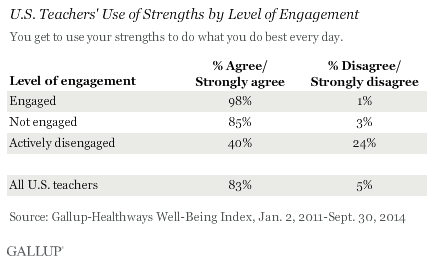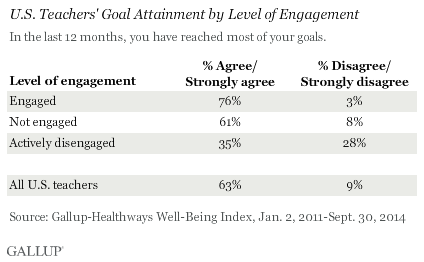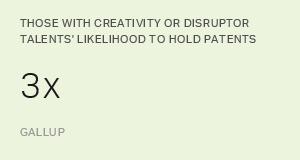Story Highlights
- Engaged teachers report higher levels of purpose well-being
- Engaged teachers report higher personal and professional satisfaction
This article is the third in a series exploring employee engagement among U.S. teachers as measured by Gallup Daily tracking.
WASHINGTON, D.C. -- Engaged teachers in the U.S. enjoy a substantially higher level of purpose well-being compared with their less-engaged colleagues. Among the nation's "engaged" teachers, 74% are thriving in purpose well-being, compared with just 35% and 12%, respectively, among "not engaged" or "actively disengaged" educators.

Overall, less than half of U.S. teachers -- just 45% -- are thriving in purpose well-being, with the majority (56%) struggling or suffering. These findings are consistent with estimates of well-being for the U.S. population more generally, measured as a part of the Gallup-Healthways Well-Being Index. Worldwide, just 18% of adults are thriving in purpose well-being, while in the U.S. this rate increases to 37% thriving.
Gallup categorizes survey participants as "engaged," "not engaged" or "actively disengaged," based on their responses to questions about workplace elements that have proven links to performance outcomes. Gallup defines engaged teachers as involved with, enthusiastic about and committed to their work. They know the scope of their jobs and constantly look for new and better ways to achieve outcomes. Not engaged teachers may be satisfied with their jobs, but they are not emotionally connected to their workplaces and are unlikely to devote much discretionary effort to their work. Actively disengaged teachers are not only unhappy, but also act out their unhappiness in ways that undermine what their coworkers accomplish.
Purpose well-being is one of the five unique elements of well-being, and is understood as people liking what they do each day and being motivated to achieve their goals.
Teacher Engagement Related to Multiple Dimensions of Purpose Well-Being
At 98% -- almost universally -- engaged teachers agree or strongly agree that they use their strengths to do what they do best every day. In contrast, just 40% of actively disengaged teachers report the same -- a more than 50-percentage-point difference -- with almost one-quarter disagreeing or strongly disagreeing that they get to use their strengths in this way every day.

Again, with near universality, 98% of teachers who are engaged in their jobs agree or strongly agree with the statement, "You like what you do every day." This is eight points higher than the 90% rate of agreement found among not-engaged teachers, and 45 points higher than is true for the nation's actively disengaged teachers.

Seventy-six percent of engaged teachers report having reached most of their goals over the past year, compared with just 35% of actively disengaged teachers and 63% of all U.S. teachers.

In addition to the personal benefits reported above, engaged teachers overwhelmingly identify a positive leader in their lives. In fact, 85% of engaged teachers agree or strongly agree with the statement, "There is a leader in your life who makes you enthusiastic about the future." Comparatively, only 37% of actively disengaged teachers and 67% of all U.S. teachers report the same.

Implications
Teachers who are engaged in their jobs enjoy a personal and professional edge compared with their less-engaged colleagues across a range of purpose metrics. In a profession plagued with turnover rates approaching 15% to almost 20% for teachers employed at high-poverty schools, the positives associated with teacher engagement cannot be overlooked.
In addition to the individual benefits of an engaged teacher workforce, positive outcomes have been traced to students whom teachers serve, as well as the school systems where they work. Gallup's report on the State of America's Schools highlights a link between teacher engagement and student engagement -- and thereby, student achievement. Additionally, a recent Gallup article indicates that the lack of engagement among U.S. teachers results in more than 2.3 million additional missed workdays every year. As such, unengaged educators are likely to affect school budgets in terms of substitute teacher costs, and school success via their classroom absence.
Engagement can serve as a key lever for enhancing well-being, and vice versa. Schools that prioritize both of these as part of teacher professional development efforts might expect a substantial return on their investments, including reduced attrition, daily stress, and use of healthcare services.
Survey Methods
Results are based on telephone interviews conducted Jan. 2, 2011-Sept. 30, 2014, as part of the Gallup Daily tracking survey, for a subgroup of 9,763 self-identified full-time K-12 school teachers, from a random sample of adults, aged 18 and older, living in all 50 U.S. states and the District of Columbia.
For results based on the total sample of U.S. teachers, the margin of sampling error is ±1.5 percentage points at the 95% confidence level. All reported margins of sampling error include computed design effects for weighting.
Each sample of national adults includes a minimum quota of 50% cellphone respondents and 50 percent landline respondents, with additional minimum quotas by time zone within region. Landline and cellular telephone numbers are selected using random-digit-dial methods.
Learn more about how the Gallup-Healthways Well-Being Index works.


